
Concept explainers
(a)
Interpretation:
It is to be determined whether and how[DK1] the given ether can be produced from a
Concept introduction:
The Williamson ether synthesis is the most convenient method for an ether synthesis. In this synthesis, an
Answer to Problem 10.16P
The given ether can be produced successfully from Williamson ether synthesis as below:

Explanation of Solution
The structure of the given ether is
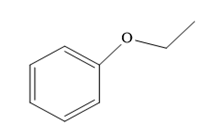
In this ether, one of the R groups is a phenyl ring, and the other is an ethyl group.
So, there are two routes to produce the desired ether by Williamson ether synthesis. Route one is discussed below.
Route I:

This is a feasible synthesis because the phenoxide ion is a good nucleophile, and the halide group attached on the primary carbon atom (primary alkyl halide) is a good substrate for a
The second possible route is discussed below.
Route II:

In this method, the halide group is on sp2 hybridized carbon, which is not acceptable for an
As Williamson ether synthesis is an
(b)
Interpretation:
It is to be determined whether and how[DK2] the given ether can be produced from a Williamson ether synthesis. And if there are two feasible syntheses for the given ether, it is to be determined which one is more preferable.
Concept introduction:
The Williamson ether synthesis is the most convenient method for an ether synthesis. In this synthesis, an alkyl halide
Answer to Problem 10.16P
The given ether cannot be synthesized by Williamson ether synthesis.
Explanation of Solution
The structure of the given ether is
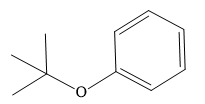
In this ether, one of the R groups is a phenyl ring, and the other is a tertiary butyl group. Those two groups would be the potential alkyl halides for a Williamson ether synthesis reaction. Route I is shown below:
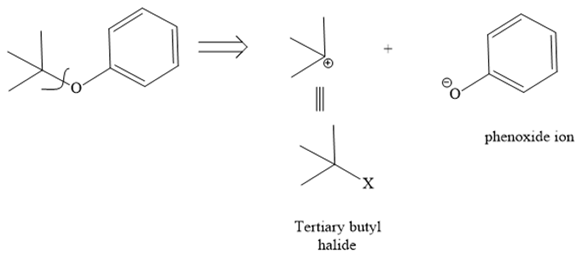
The retrosynthesis suggests that the given ether can be synthesized from a tertiary butyl halide as a substrate and a phenoxide ion as a nucleophile. But the alkyl halide has a leaving group on the tertiary carbon, so it will not follow an
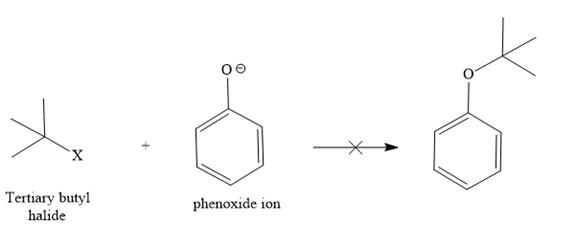
Instead, it shows an E1 reaction with the phenoxide ion because the phenoxide ion acts as a base instead of the nucleophile due to bulkiness.

The second route is not acceptable because the positive charge comes on [DK4] the carbon atom of a phenyl ring, which is already electron-rich and sp2, which is not good for the
Route II:

Since both routes do not give the desired ether as a product via
As Williamson ether synthesis is an
(c)
Interpretation:
It is to be determined whether and how[DK5] the given ether can be produced from a Williamson ether synthesis. And if there are two feasible syntheses for the given ether, it is to be determined which one is more preferable.
Concept introduction:
The Williamson ether synthesis is the most convenient method for an ether synthesis. In this synthesis, an alkyl halide
Answer to Problem 10.16P
The given ether can be successfully produced from a Williamson ether synthesis via two routes as below:
Route I:

Route II:

The first route is more preferable as it makes use of a primary alkyl halide as a substrate.
Explanation of Solution
The given ether is
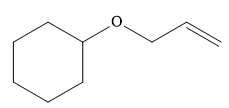
One R group in the given ether is cyclohexane while the other is an allyl group. Both of these R groups can be potentially used as substrates in the Williamson ether synthesis. Route I is shown below:

In this route, the leaving group (halogen atom, X) is on the primary carbon, and an alkoxide ion is also a good nucleophile, so the reaction can proceed through
The other route for the synthesis of the given ether is shown below:
Route II:

In this route, the leaving group (halogen atom, X) is on the secondary carbon, and an alkoxide ion is also a good nucleophile, so the reaction can proceed through
Note that both routes are feasible for the given ether synthesis, but the substrate of both routes is different. In the first route, the substrate (alkyl halide) has a leaving group on primary carbon while in the second route it is on the secondary carbon. Since an
As Williamson ether synthesis is an
Want to see more full solutions like this?
Chapter 10 Solutions
Organic Chemistry: Principles and Mechanisms (Second Edition)
- Identifying the major species in weak acid or weak base equilibria The preparations of two aqueous solutions are described in the table below. For each solution, write the chemical formulas of the major species present at equilibrium. You can leave out water itself. Write the chemical formulas of the species that will act as acids in the 'acids' row, the formulas of the species that will act as bases in the 'bases' row, and the formulas of the species that will act as neither acids nor bases in the 'other' row. You will find it useful to keep in mind that HF is a weak acid. 2.2 mol of NaOH is added to 1.0 L of a 1.4M HF solution. acids: П bases: Х other: ☐ ப acids: 0.51 mol of KOH is added to 1.0 L of a solution that is bases: 1.3M in both HF and NaF. other: ☐ 00. 18 Ararrow_forwardUsing reaction free energy to predict equilibrium composition Consider the following equilibrium: N2O4 (g) 2NO2 (g) AG⁰ = 5.4 kJ Now suppose a reaction vessel is filled with 1.68 atm of dinitrogen tetroxide (N204) at 148. °C. Answer the following questions about this system: rise Under these conditions, will the pressure of N2O4 tend to rise or fall? x10 fall Is it possible to reverse this tendency by adding NO2? In other words, if you said the pressure of N2O4 will tend to rise, can that be changed to a tendency to fall by adding NO2? Similarly, if you said the pressure of N2O4 will tend to fall, can that be changed to a tendency to rise by adding NO2? If you said the tendency can be reversed in the second question, calculate the minimum pressure of NO 2 needed to reverse it. Round your answer to 2 significant digits. yes no 0.42 atm ☑ 5 0/5 ? مله Ararrow_forwardHomework 13 (Ch17) Question 4 of 4 (1 point) | Question Attempt: 2 of 2 ✓ 1 ✓ 2 = 3 4 Time Remaining: 4:25:54 Using the thermodynamic information in the ALEKS Data tab, calculate the standard reaction free energy of the following chemical reaction: 2CH3OH (g)+302 (g) → 2CO2 (g) + 4H₂O (g) Round your answer to zero decimal places. ☐ kJ x10 ☐ Subm Check 2020 Hill LLC. All Rights Reserved. Terms of Use | Privacy Cearrow_forward
- Identifying the major species in weak acid or weak base equilibria Your answer is incorrect. • Row 2: Your answer is incorrect. • Row 3: Your answer is incorrect. • Row 6: Your answer is incorrect. 0/5 The preparations of two aqueous solutions are described in the table below. For each solution, write the chemical formulas of the major species present at equilibrium. You can leave out water itself. Write the chemical formulas of the species that will act as acids in the 'acids' row, the formulas of the species that will act as bases in the 'bases' row, and the formulas of the species that will act as neither acids nor bases in the 'other' row. You will find it useful to keep in mind that HF is a weak acid. acids: HF 0.1 mol of NaOH is added to 1.0 L of a 0.7M HF solution. bases: 0.13 mol of HCl is added to 1.0 L of a solution that is 1.0M in both HF and KF. Exponent other: F acids: HF bases: F other: K 1 0,0,... ? 000 18 Ararrow_forwardUsing reaction free energy to predict equilibrium composition Consider the following equilibrium: 2NOCI (g) 2NO (g) + Cl2 (g) AGº =41. kJ Now suppose a reaction vessel is filled with 4.50 atm of nitrosyl chloride (NOCI) and 6.38 atm of chlorine (C12) at 212. °C. Answer the following questions about this system: ? rise Under these conditions, will the pressure of NOCI tend to rise or fall? x10 fall Is it possible to reverse this tendency by adding NO? In other words, if you said the pressure of NOCI will tend to rise, can that be changed to a tendency to fall by adding NO? Similarly, if you said the pressure of NOCI will tend to fall, can that be changed to a tendency to rise by adding NO? yes no If you said the tendency can be reversed in the second question, calculate the minimum pressure of NO needed to reverse it. Round your answer to 2 significant digits. 0.035 atm ✓ G 00. 18 Ararrow_forwardHighlight each glycosidic bond in the molecule below. Then answer the questions in the table under the drawing area. HO- HO- -0 OH OH HO NG HO- HO- OH OH OH OH NG OHarrow_forward
- € + Suppose the molecule in the drawing area below were reacted with H₂ over a platinum catalyst. Edit the molecule to show what would happen to it. That is, turn it into the product of the reaction. Also, write the name of the product molecule under the drawing area. Name: ☐ H C=0 X H- OH HO- H HO- -H CH₂OH ×arrow_forwardDraw the Haworth projection of the disaccharide made by joining D-glucose and D-mannose with a ẞ(1-4) glycosidic bond. If the disaccharide has more than one anomer, you can draw any of them. Click and drag to start drawing a structure. Xarrow_forwardEpoxides can be opened in aqueous acid or aqueous base to produce diols (molecules with two OH groups). In this question, you'll explore the mechanism of epoxide opening in aqueous acid. 2nd attempt Be sure to show all four bonds at stereocenters using hash and wedge lines. 0 0 Draw curved arrows to show how the epoxide reacts with hydronium ion. 100 +1: 1st attempt Feedback Be sure to show all four bonds at stereocenters using hash and wedge lines. See Periodic Table See Hint H A 5 F F Hr See Periodic Table See Hintarrow_forward
- 03 Question (1 point) For the reaction below, draw both of the major organic products. Be sure to consider stereochemistry. > 1. CH₂CH₂MgBr 2. H₂O 3rd attempt Draw all four bonds at chiral centers. Draw all stereoisomers formed. Draw the structures here. e 130 AN H See Periodic Table See Hint P C Brarrow_forwardYou may wish to address the following issues in your response if they are pertinent to the reaction(s) you propose to employ:1) Chemoselectivity (why this functional group and not another?) 2) Regioselectivity (why here and not there?) 3) Stereoselectivity (why this stereoisomer?) 4) Changes in oxidation state. Please make it in detail and draw it out too in what step what happens. Thank you for helping me!arrow_forward1) Chemoselectivity (why this functional group and not another?) 2) Regioselectivity (why here and not there?) 3) Stereoselectivity (why this stereoisomer?) 4) Changes in oxidation state. Everything in detail and draw out and write it.arrow_forward
 Organic Chemistry: A Guided InquiryChemistryISBN:9780618974122Author:Andrei StraumanisPublisher:Cengage Learning
Organic Chemistry: A Guided InquiryChemistryISBN:9780618974122Author:Andrei StraumanisPublisher:Cengage Learning
